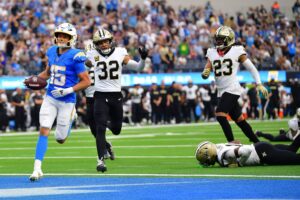As if the Kansas City Chiefs enjoyed inducing proverbial pain on the coaching staff, the dance in New York was a display of fireworks launched equally at the New York Jets defense and the themselves. On one side of the stage, Alex Smith launched four touchdowns and carried the offense to a staggering 31-point display. But, shamefully and loudly exiting stage left was the Chiefs defense; epitomized with allowing 13 of 20 third-down conversions, making Josh McCown appear 21 again, and Marcus Peters launching referee’s flags into the crowd in petty frustration. Mentally, the Chiefs usual austere presentation has left in the wake of a tragic slide to 6-6. Statistically, the defense is nothing more than a wallowing dance of depression. No matter how bright the Chiefs offensive performance, overcoming a 38-point deficit is futile. The Kansas City Chiefs week 13 stats display a team embattled in incompetent functionality, finding new ways to self-impose tragedy.
Kansas City Chiefs Week 13 Stats and Charts – Self-Imposed Tragedy
Chaos Theory
(At this point in the season, it might be a good time to revisit the concept of chaos theory. In week one, the mathematical debauchery was explained as essentially a fractal graph that assigned value to outcomes in a game, defining which team had more momentum or chaos control.)
The finest way to renounce offensive woes and create instant chaos is launching a 22-yard pass for a touchdown. And that is exactly what Smith did, targeting Travis Kelce a mere five plays into the game and netting the first touchdown. The chaos only descended farther on the Jets when the next drive took Smith one play to repeat the dance, connecting with Kelce for another 36-yard touchdown bomb.
The shock and awe behind Matt Nagy’s reformatted game plan (Nagy took over play calling before the game) mathematically took control of the game in a way the Chiefs had not done since earlier in the season. A Jets roster prone to faltering when needing to create comebacks should commenced their own self-imposed doom.
However, the Jets had other plans. Despite Darrelle Revis making his debut for a secondary needing veteran leadership, McCown chipped away with large gains to put the offense at the one-yard line. Bilal Powell scored from one-yard out, taking back some chaos. Mathematically, the game was in clear control for the Chiefs, but only for a few more ticks of the clock.
Commence the shoot-out of chaos. The Jets took their next drive for a touchdown after being stopped on third down, converting a fourth, and taking five minutes off the clock. What once was concise control of chaos, the Jets took and began churning a mathematical fractal which implicated the Chiefs giving up opportunity. Throughout the rest of the first half, the Chiefs defense had three distinct movements where they could have reasserted momentum in their control. By halftime the 14-0 lead had turned into a 21-17 Jets lead with their offense operating at will.
The embarrassing performance continued into the second half. The nuances of the bevy of opportunity the Chiefs defense had to stop the Jets would be too expansive herein. Suffice it to say, there were 14 attempts for the Chiefs defense to take momentum back in their control, and 14 times they failed. The result was a loss in which the Jets controlled the ball for 42:49, while the Chiefs held possession merely 17:11.
A missed field goal, ending Harrison Butker’s franchise streak, in the second quarter ought to be noted. While the 38-yard miss kept points from the board, the momentum was ultimately not driven away from the Chiefs at that point as the Jets punted on the next series.
The key difference came in a theoretical six more minutes of Chiefs ball control would have taken a Jets score off the board, and provided the Chiefs a tangible way to win. On the final offensive drive, the Chiefs were within field goal range, but needed to put the ball in the end zone and convert the extra point to just align the score at 38 for overtime.
Changing Pace – Anomaly or New Look?
As mentioned before, the Chiefs offense came out and struck with immediate potency. The Jets single coverage with Morris Claiborne and Demario Davis was exposed by Nagy’s play calling. At the end of the day, Smith was brilliant, completing 19 passes on 33 attempts for 366 yards and four touchdowns. Include in that mix a wild 70-yard rush, and Smith put on a rare show usually reserved for his September outings.
However, not every team plays the Jets defensive schemes. As refreshing as the outing was, it may prove to be more of an anomaly. Smith targeted receivers deep 10 times, completing five, the highest amount of deep targets the season. This is partial to Nagy’s emphasis on going deep based on the intrinsic scheme instead of merely when the play call came up on the script. Suffice it to say, Nagy was not bound to a stubborn playbook.
Still, there were several key takeaways in the shorter passing range that can sustain Nagy’s play calling no matter the opponent. Many of the passes Smith threw were not built upon the receiver creating yardage after the catch, but the route creating the yardage by going slightly deeper downfield. Part of the success of the offensive output was seen in slant routes and quick timing routes built farther than a mere five yards downfield.
Partially an effect of the deep passes, but the Chiefs did achieve their longest net yards per attempt mark at 10.3.
The middle was also targeted less, only thrice in fact. In games past, this is where Andy Reid often placed Kelce to catch passes. Nagy used more exterior plays, again, part and parcel to the Jets being exposed at that side of the field. Albert Wilson came in handy across the board, netting 27 yards on three receptions. Even Demarcus Robinson was worked into the Chiefs system to complement the outside pass with two receptions.
If Smith and the offense can sustain passes that are marginally longer downfield, then they can grind out drives with the passing game as well as explode when needed. The definitive reliance on the run-game to be magical will begin to fade, allowing for flexibility.
One of the strange utilizations of the Chiefs’ fastest player, Tyreek Hill, was Reid’s lack of will to use him as an isolated deep target. Previously he saw two or less targets deep per game, save the Houston Texans matchup where he was targeted in that role thrice. However, under Nagy, he got the call five different times, and was aligned as an isolated exterior receiver threat in plays even when not the main read.
If Hill is used more often in sets where he can create mismatches with speed, the Chiefs gain two advantages. First, the obvious speed will burn corners and create mismatches. Second, to stop Hill on the outside, teams will have to draw a safety over to cover him. Inevitably, that opens a lane for quick under routes to evolve into slightly longer routes.
Let the positivity happily ring, because the remainder of the statistical trends are disappointing. Beginning with the run game, Kareem Hunt got the ball only nine times for 40 yards. He did have one spectacular 14-yard momentous push, but had trouble with consistency outside of that.
Fortunately, 17 minutes of offense, much of which featured the pass succeeding, is not a good litmus test for the running game coming around. The Chiefs handling of their system will be better tested against the Oakland Raiders this upcoming week.
A Loss of Function
The statistical lines begin to get even more depressing when the defense is torn apart. Not only did the Chiefs defense regress against the Jets, but they turned out their worst performance of the season. Allowing the Jets to convert 13 of 20 third downs whips up a losing recipe, further epitomized in the 43 minutes the Jets controlled the ball.
Since 1940, 55 teams have controlled the clock for more than 42 minutes, discounting overtime; only two have lost. Since 1991 (time shortened due to statistical keeping and again discounting overtime), only 10 teams have converted 65 percent or more of third downs when faced with 20 attempts. Only one team lost.
The implication is the Chiefs defense initiated self-destruction by playing definitively inept and unprincipled football. For the Chiefs to win, their offense would have had to put up Peyton Manning status.
(Fun fact: Manning led the Indianapolis Colts to beat the Miami Dolphins in 2009 despite having the ball 15 minutes and the Colts defense allowing the Dolphins to convert 15 of 21 third downs).
McCown was formidable on the afternoon, not only controlling the ball through the air, but offering his assistance on the ground. Twice McCown pushed the ball in on his own leg power, netting the second time he has done so since turning 35. In fact, Doug Flutie is the only other quarterback in NFL history to rush for two touchdowns in a game since turning 35.
The endless fun facts serve to put an onus on the Chiefs lack of will. This was a game they should have managed instead of dinking around the field for 45 minutes. The Jets as an offense ran egregiously high 49 times during those 45 minutes, creating explosive plays and forcing frequent run-to-fit mistakes. Despite the bevy of plays ran and opportunities to net tackles, Steven Nelson lead the team with nine net tackles from the cornerback position, four of which came in the run game.
To put the tackle tally in even further context, 18 of 57 run tackles (including shared tackles) were completed by secondary members. That means around 18 times a Jet running back broke into the secondary or a linebacker had to be assisted by a safety or corner. Those kinds of gaps cannot occur.
The pass defense was also spinning in circles for most of the day. From Peters to Revis, the Jets were toying with the corners. Robby Anderson caught eight of 12 targets for 107 yards, while Jermaine Kearse caught nine of 10 targets for 157 yards. Running backs Matt Forte jumped in with three of three targets for 33 yards, including a 21-yard explosion.
The most concerning attribute was the unwillingness for the Chiefs to morph or adhere to any kind of new game plan. They simply let the egregious play style insistently chip away at their defense as they were step behind almost every play.
Although there was not statistic for speed, one play epitomized the performance. Forte caught a quick pass from McCown with 29 seconds left in the second quarter. Derrick Johnson stepped up to make the tackle, but the 31-year-old running back quickly wound his way around Johnson and into the end zone. Johnson was left staring at Forte in front of him.
No matter what needs to change, the litany of embarrassing statistics for the Chiefs defense provides they need to change more than just scheme, but their entire mental approach to the game of football.
Main Image:






